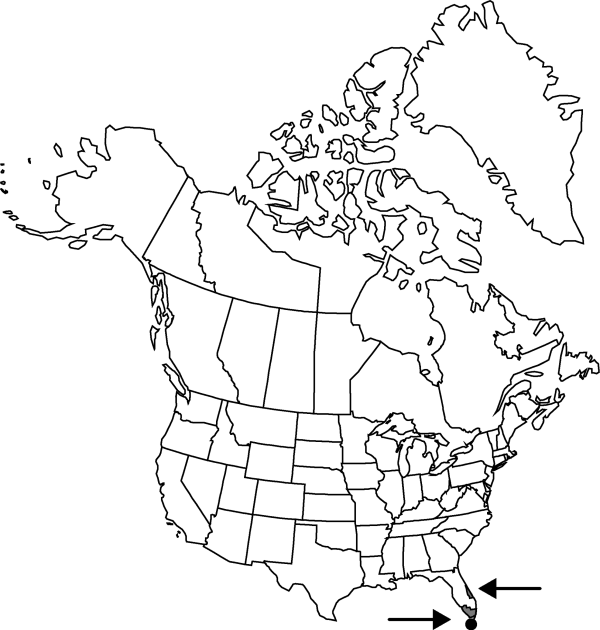Difference between revisions of "Harrisia simpsonii"
Cact. 2: 152, fig. 223. 1920.
FNA>Volume Importer |
imported>Volume Importer |
||
| (7 intermediate revisions by 2 users not shown) | |||
| Line 8: | Line 8: | ||
}} | }} | ||
|common_names=Simpson’s prickly apple;Simpson’s applecactus;queen-of-the-night | |common_names=Simpson’s prickly apple;Simpson’s applecactus;queen-of-the-night | ||
| + | |special_status={{Treatment/ID/Special_status | ||
| + | |code=E | ||
| + | |label=Endemic | ||
| + | }}{{Treatment/ID/Special_status | ||
| + | |code=C | ||
| + | |label=Conservation concern | ||
| + | }} | ||
|basionyms= | |basionyms= | ||
|synonyms={{Treatment/ID/Synonym | |synonyms={{Treatment/ID/Synonym | ||
|name=Cereus gracilis var. simpsonii | |name=Cereus gracilis var. simpsonii | ||
|authority=(Small ex Britton & Rose) L. D. Benson | |authority=(Small ex Britton & Rose) L. D. Benson | ||
| + | |rank=variety | ||
}} | }} | ||
|hierarchy=Cactaceae;Cactaceae subfam. Cactoideae;Harrisia;Harrisia simpsonii | |hierarchy=Cactaceae;Cactaceae subfam. Cactoideae;Harrisia;Harrisia simpsonii | ||
| Line 20: | Line 28: | ||
}}<!-- | }}<!-- | ||
| − | --><span class="statement" id="st- | + | --><span class="statement" id="st-undefined" data-properties=""><b>Stems </b>erect, reclining, or clambering, sometimes epiphytic and vinelike, to 4 m; ribs 9–10. <b>Spines</b> 7–9 per areole, 1–2.5 cm, yellow tipped or completely yellowish when young. <b>Flowers</b>: flower tube 10–15 cm, prominently ridged; scales turgid at base, with axillary tufts of hairs; hairs, white, soft and silky, flexible, 6–10 mm; buds with white hairs. <b>Fruits</b> dull red at maturity, depressed-spheric, 40–60 mm diam.</span><!-- |
-->{{Treatment/Body | -->{{Treatment/Body | ||
| + | |phenology=Flowering spring–summer. | ||
|habitat=Sandy soils of dense thickets and hammocks, mangrove swamps | |habitat=Sandy soils of dense thickets and hammocks, mangrove swamps | ||
|elevation=0 m | |elevation=0 m | ||
|distribution=Fla. | |distribution=Fla. | ||
|discussion=<p>Of conservation concern.</p><!-- | |discussion=<p>Of conservation concern.</p><!-- | ||
| − | --><p>D. F. Austin (1984) suggested that the isolated populations and/or clones of Harrisia simpsonii are as different from each other as are the two species, H. aboriginum and H. simpsonii. These observations imply that varietal rank might be more suitable for the two taxa. Further study is warranted.</p><!-- | + | --><p>D. F. Austin (1984) suggested that the isolated populations and/or clones of <i>Harrisia simpsonii</i> are as different from each other as are the two species, <i>H. aboriginum</i> and <i>H. simpsonii</i>. These observations imply that varietal rank might be more suitable for the two taxa. Further study is warranted.</p><!-- |
--><p>A number of nocturnal-flowering cereoid species with large, white flowers are known as “queen-of-the-night.”</p> | --><p>A number of nocturnal-flowering cereoid species with large, white flowers are known as “queen-of-the-night.”</p> | ||
|tables= | |tables= | ||
| Line 37: | Line 46: | ||
-->{{#Taxon: | -->{{#Taxon: | ||
name=Harrisia simpsonii | name=Harrisia simpsonii | ||
| − | |||
|authority=Small ex Britton & Rose | |authority=Small ex Britton & Rose | ||
|rank=species | |rank=species | ||
| Line 44: | Line 52: | ||
|basionyms= | |basionyms= | ||
|family=Cactaceae | |family=Cactaceae | ||
| + | |phenology=Flowering spring–summer. | ||
|habitat=Sandy soils of dense thickets and hammocks, mangrove swamps | |habitat=Sandy soils of dense thickets and hammocks, mangrove swamps | ||
|elevation=0 m | |elevation=0 m | ||
| Line 50: | Line 59: | ||
|publication title=Cact. | |publication title=Cact. | ||
|publication year=1920 | |publication year=1920 | ||
| − | |special status= | + | |special status=Endemic;Conservation concern |
| − | |source xml=https:// | + | |source xml=https://bitbucket.org/aafc-mbb/fna-data-curation/src/2e0870ddd59836b60bcf96646a41e87ea5a5943a/coarse_grained_fna_xml/V4/V4_296.xml |
|subfamily=Cactaceae subfam. Cactoideae | |subfamily=Cactaceae subfam. Cactoideae | ||
|genus=Harrisia | |genus=Harrisia | ||
|species=Harrisia simpsonii | |species=Harrisia simpsonii | ||
| − | |||
| − | |||
| − | |||
| − | |||
| − | |||
| − | |||
| − | |||
| − | |||
| − | |||
| − | |||
| − | |||
| − | |||
| − | |||
| − | |||
| − | |||
| − | |||
| − | |||
| − | |||
| − | |||
| − | |||
| − | |||
| − | |||
}}<!-- | }}<!-- | ||
-->[[Category:Treatment]][[Category:Harrisia]] | -->[[Category:Treatment]][[Category:Harrisia]] | ||
Latest revision as of 22:57, 5 November 2020
Stems erect, reclining, or clambering, sometimes epiphytic and vinelike, to 4 m; ribs 9–10. Spines 7–9 per areole, 1–2.5 cm, yellow tipped or completely yellowish when young. Flowers: flower tube 10–15 cm, prominently ridged; scales turgid at base, with axillary tufts of hairs; hairs, white, soft and silky, flexible, 6–10 mm; buds with white hairs. Fruits dull red at maturity, depressed-spheric, 40–60 mm diam.
Phenology: Flowering spring–summer.
Habitat: Sandy soils of dense thickets and hammocks, mangrove swamps
Elevation: 0 m
Discussion
Of conservation concern.
D. F. Austin (1984) suggested that the isolated populations and/or clones of Harrisia simpsonii are as different from each other as are the two species, H. aboriginum and H. simpsonii. These observations imply that varietal rank might be more suitable for the two taxa. Further study is warranted.
A number of nocturnal-flowering cereoid species with large, white flowers are known as “queen-of-the-night.”
Selected References
None.
